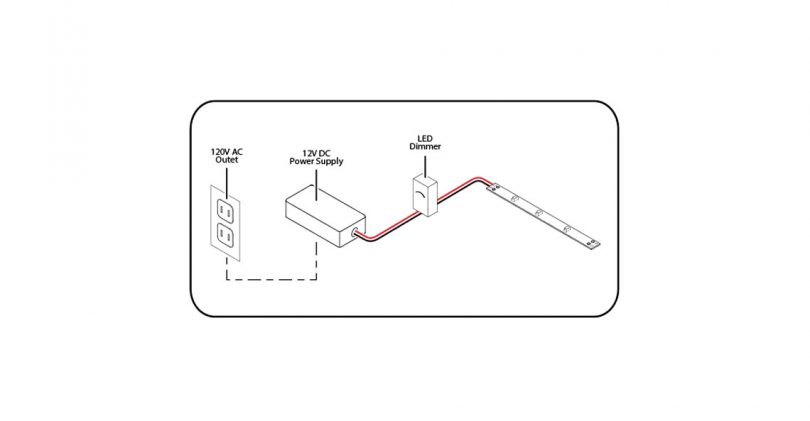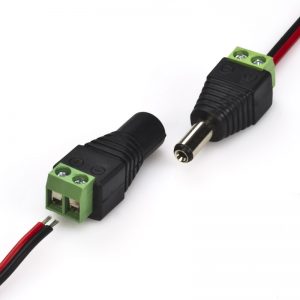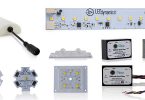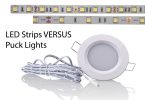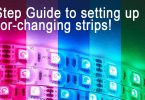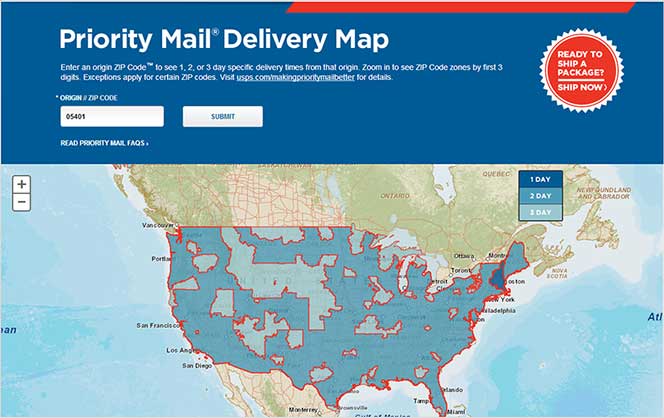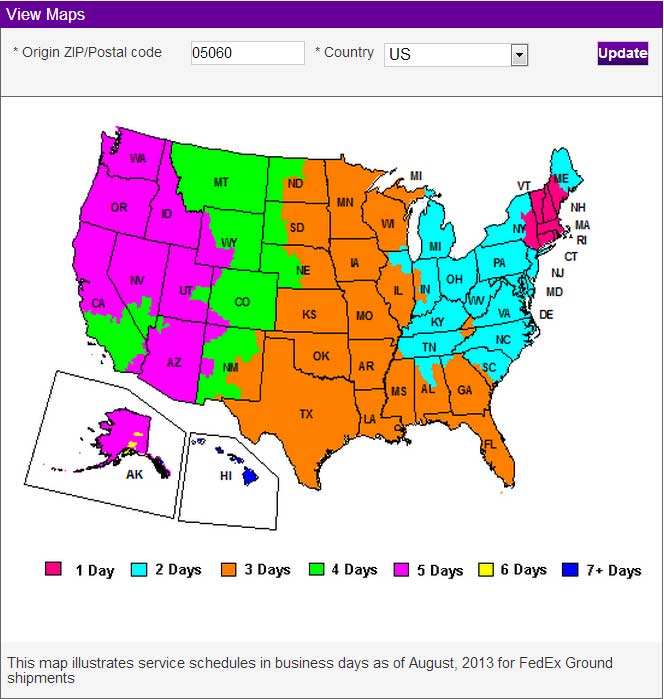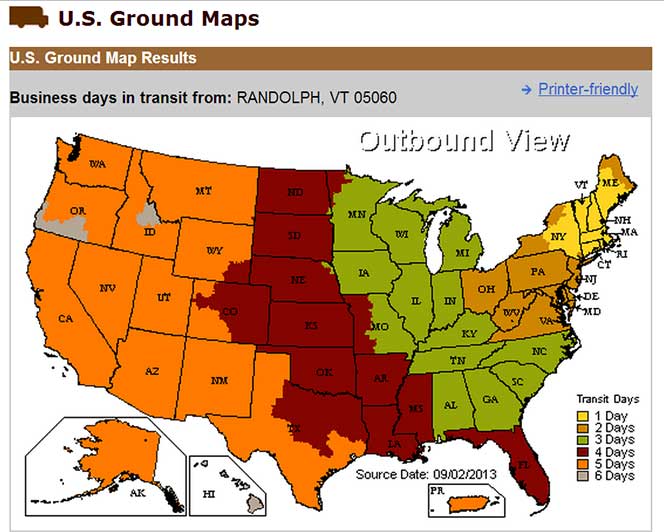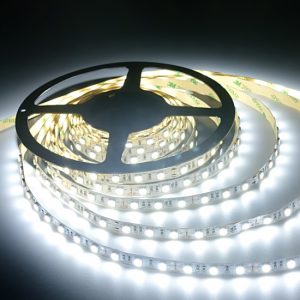
LED strip lights have become a quick and efficient answer to providing accent lighting around your home. A relatively low cost option is low voltage, 12 volt LED strip lighting. These discrete strips are sometimes called led ribbon lights or flexible led strips, referring to the ease at which they form to any surface to provide a soft, smooth accent light. Their low 12VDC power input makes them run at an efficient rate while 5050 LEDs keep it running cool and safe to run in tight spaces. All of these factor into what makes 12V LED strips so great for under cabinet lighting, accent lighting, bookshelf lighting, task lighting, cove lighting and so much more. Since they are 12VDC powered they are also popular in car and boat applications. Throughout this post we will go through how to make sure you are powering your LED strips correctly and different ways of wiring your strips to make for the best LED lighting set up.
The Basics of 12V Flexible LED Strips
Their name says it all, these strips have a flexible linear base that holds 5050 LEDs on it. 5050 is just the size/type of LED. This is a common size for LED strip lights, they are big and bright but still run cool. 3528 is another common LED type used in LED strips, I would avoid these as they are a lot smaller and dimmer. Any larger than 5050 and the lighting becomes much more expensive, and runs much hotter, bringing heatsinking and temperature control into the mix.
These LED flex strips come in natural white colors: 3000K (Warm-White), 4000K (Neutral-White) and 6500K (Cool-White). Color LED strips are also available in Red, Yellow, Green, Blue and RGB (color-changing). For more info on the basics of 12V flex strips, check here.
Those choosing white LED strips have a choice between two different densities. The density is just the amount of LEDs within a distance along the strip. The standard density strips have 30 LEDs/meter (150 per reel) that give off about 540 Lumens per meter. The high density strip doubles that with 60 LEDs/meter (300 per reel) and give off 1080 Lumens per meter! Those looking for the brightest light they can get for task lighting should definitely go with the high density as they are significantly brighter. Accent lighting typically just needs a soft glow, however, which is where you could use the standard density as they are priced lower and won’t be too overpowering. NOTE that high density strips will run at a higher wattage but we will go into powering below.
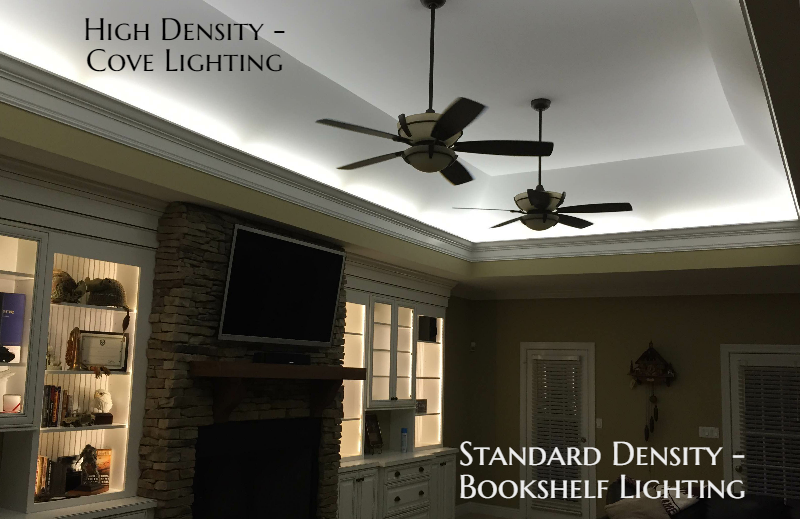
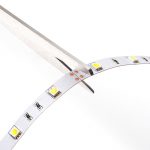
12V LED strips come in reels of 16.4 feet (5m). Here at LEDSupply we offer smaller lengths of 3, 6, 9 and 12 feet. The strips can easily be cut down to size as there are cut marks along with solder pads every 4 inches for standard density and every 2 inches for high density. Here is an easy run through of how to cut custom lengths and add connectors in order to connect strips together.
The lightweight flexible strips mount easy as they are backed with adhesive tape that will stick to your surface, flat or rounded. They are also covered in a silicone coating to protect from water. Using 12 volt led light strips will cut down on set up time and the overall cost of your project. Probably the two biggest problems people run into is (1) not knowing what size wattage power supply to purchase, or (2) how to connect multiple strips, either together or back to the same power source. Below we will dive into some good practices for powering your LED strips.
Powering LED Strips
A constant 12VDC input is required for these strips. The only other thing you need to know in terms of finding a power supply for your LED strips is the wattage. The specs below lists wattage for both standard and high density strip lights. This will help you find the wattage of your system easily and then select the appropriate power supply.
| Length (Ft.) | Length (Meters) | 30 LEDs/M Wattage | 60 LEDs/M Wattage |
| 1 | 0.3048 | 2.4 | 4.8 |
| 2 | 0.6096 | 4.8 | 9.6 |
| 3 | 0.9144 | 7.2 | 14.4 |
| 6 | 1.8288 | 12.15 | 20.8 |
| 9 | 2.7432 | 22.05 | 33.6 |
| 12 | 3.6576 | 22.05 | 33.6 |
| 16.4 (Full Reel) | 5 | 27 | 40 |
Calculating Wattage, Example #1: So imagine you just have a length of about 20 feet that you need to cover in one solid run with Standard Density strips. This would be achieved by using a full reel and then adding on 4 extra feet with a gapless connector. Using the table above we can find this.
Wattage = Full Roll Wattage (Standard) + 3Ft. Wattage + 1Ft. Wattage
Wattage = 27 Watts + 7.2 + 2.4
Wattage = 36.6 Watts
You usually want to give some cushion between your wattage and the rated wattage of the power supply. With this application you should find a 12V power supply capable of at least 40 Watts.
Calculating Wattage, Example #2: Take for example you want to run 18 feet of high density LED strips for another application.
Wattage = Full Reel (high density) x 2Ft. Wattage
Wattage = 40 + 9.6
Wattage = 49.6 Watts
For this application I would stick with a 50 Watt power supply at least. Remember we want to give the supply a little cushion so you would be safer choosing a 60 Watt power supply.
LED Power Supply Options
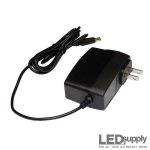
The first option would be to go with a plug-in power brick. Wall Wart or desktop power supplies will plug directly into your wall outlet and switch the line voltage down to 12VDC for the strips. This is handy for smaller applications or in spots where you have a hidden outlet that is out of the way. It certainly makes wiring easier as you just plug in and don’t have to connect wires directly to main lines.
This brings us to our second option, a hardwired power supply that connects straight to 120VAC lines and then outputs the safe, low DC voltage to your strips. These power supplies typically come in more discrete sizes and can be much easier to hide within walls or wherever needed. Caged, Open Frame Power supplies typically fall in this category as well and are very helpful with their screw-in terminal ports for easy connections and multiple ports. This is definitely a more professional look than just plugging straight into a wall but it will require you to have main lines readily available by your lights.
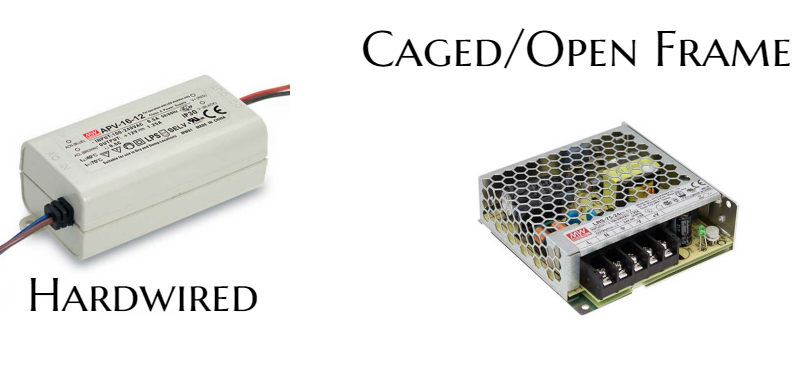
Connecting LED Strips to Power Supply
Connecting strips to power is fairly simple, it just changes depending on your power source and such. For those going with a plug in power supply, the output connection is usually a 2.1mm Male Barrel plug. Luckily full reels of strips come with a 2.1mm female plug to make a seamless connection, if you have a shorter length you can use the screw-in terminal connectors below.
With hardwired power supplies it is a little different as they have wire leads coming off, no direct plugs. If your strip has the 2.1mm female plug on it then it might be easiest to connect a screw-in terminal connector (2.1 male) to the output wires of the power supply so you can make a sound connection. You also have the option of cutting the connector off your strip and just making wire to wire connections using solder or wire nuts.
How to Connect Multiple Strips to One Power Source
Connecting multiple strips to one source throws a loop in the project as there is usually just one connection to the power source. Caged, Open Frame Power supplies are fantastic for using multiple strips as they have two channels with terminal ports where multiple strips could go in each.

If you need to go with a plug-in style, then I would suggest running both your strip connections into an LED Strip Splitter which will then plug seamlessly into the male plug of the power brick. LED Strip splitter cables come in up to 4-outputs so you could potentially have 4 strips running seamlessly from one Power Supply connection!
When hardwiring the strips, you will just need to make solid connections between all your strip wires to the output wires on the power supply. This can be done with wire nuts or wiring all strips to a common positive and negative wire so you can make a one to one connection with the hardwired power supply.
Voltage Drop and How to Avoid It
A very important consideration that is commonly overlooked with these flex strips is the effect of Voltage Drop. In DC circuits, voltage will gradually decrease as it travels through wire (or LED strip). Simply put, with each foot of wire, the available voltage to each foot drops along the length of wire. This will effect Standard Density Strips wanting to go longer than 32 feet and High Density Strips wanting to go longer than a full reel (16.4 feet). If you go longer than these lengths, the strips will be affected and will not work properly, so you cannot chain strips together longer than 32 for standard density and 16.4 for high density.
To prevent voltage drop you will want to divide long runs of LED strips into shorter lengths. The shorter lengths can then connect in parallel from the power supply. There are a couple different ways you can make this happen, lets take a look at the different wiring setups below.
Wiring #1: Running multiple parallel runs of strip lights
You want to install a continuous run of 60 feet of LED strips underneath a bar counter for accent lighting. Since the longest run you can make is 32 feet, you will need to split it into at least 2 lengths. In order to do two equal parts, you should run two strips at 30 feet each. Run the first strip straight from the power source. Run a parallel set of wires to the point where the first strip ends to feed the second strip with power.

Wiring #2: Power Supply in the Middle Approach
This is a great approach if you can somehow put your power source in the middle of a long length of strips you need to run. This way it cuts down on extra wire lengths as you can split it in half and just run both strips in opposite directions straight from the source.

Wiring #3: Use Multiple Power Supplies
Sometimes, rather than run long lengths of wire and split up the wires going from the power supply, customers will choose to use separate power supplies in different areas. This works great if you can supply power in the specific places you would need them, but that is the tricky part.
Helpful Parts for Connecting LED Strips to Power
This should get you well on your way to setting up your LED strip lights with the right wiring setup and power supply. Like always we wanted to leave you with some helpful parts that will really make connecting strips together a whole lot easier.
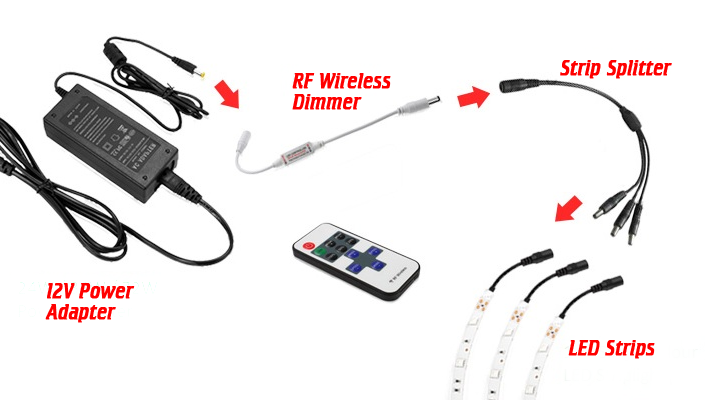
LED Strip Splitters: These LED Y-Connectors make it so you can plug in one power source and connect multiple LED runs off it with a simple plug in connection. These are available in RGB and single color options and available in two, three and four output connections.
Screw-In Terminal Connectors: These small connectors come in super handy when you need to make solid connections between two sets of wires. Just by a male and female end, screw down your wire connections for both and plug in with ease. Also works when you need to go from wire leads to a 2.1 or 2.5mm plug of some sort.
EZ Clip LED Strip Connectors: These connectors snap right onto the end of you strips where you cut them. There are strip-to-strip or strip-to-wire options. This makes it easy to connect LED strips or add gaps within the installation without having to solder.
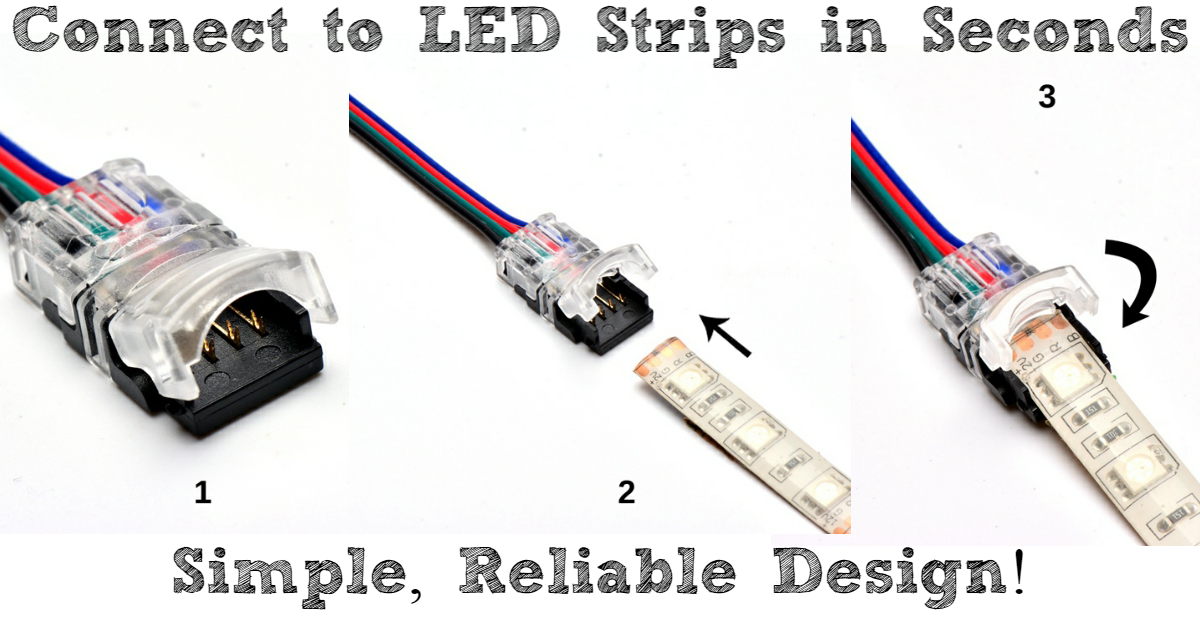
Old Fashioned Way: Break out the solder iron and wire and make those connections the way we do here.





































